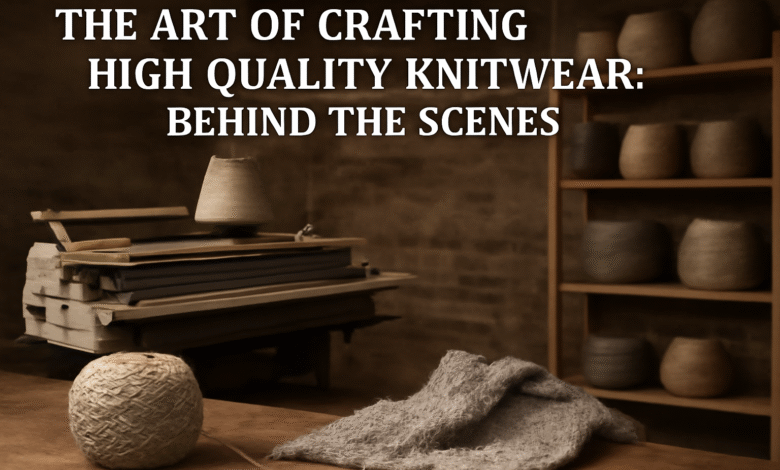The Art of Crafting High-Quality Knitwear: Behind the Scenes

Knitwear has always held a special place in the world of fashion and comfort. From cozy sweaters to elegant scarves, the world of knitwear combines artistry, skill, and the timeless appeal of handmade textiles. Creating high-quality knitwear is an intricate process that blends tradition and innovation, ensuring each piece is not only durable but also luxurious. Behind every beautifully crafted knit garment lies a network of skilled artisans, state-of-the-art machinery, and careful attention to detail. In this blog, we take a look at the fascinating process of creating high-quality knitwear and the artistry that goes into every stitch.
The Journey from Yarn to Garment
The foundation of any beautiful knitwear piece begins with the yarn. Yarn comes in many varieties—ranging from soft wool to luxurious cashmere, to more sustainable fibers like organic cotton. The choice of yarn is critical because it determines the texture, weight, and durability of the finished product. Each fiber type behaves differently, offering unique qualities that will shine through in the finished garment.
Once the yarn is selected, the knitting process begins. The magic of knitting happens through a sequence of interconnected loops, created by specialized machines or by hand. While hand-knitted garments possess a certain charm, modern high-quality knitwear often relies on advanced knitting technology to ensure consistency and precision.
High-Quality Knitwear Manufacturing Process
High-quality knitwear manufacturing is a meticulous process that begins with a design concept. Designers work to blend aesthetics with functionality, creating pieces that look as beautiful as they feel. They consider factors like pattern creation, stitch techniques, and even the fit of the garment. The designers work closely with knitting technicians who bring these ideas to life on machines designed for precision.
Once the knitting process is complete, the garment undergoes a series of finishing techniques. These techniques are what set high-quality knitwear apart from the rest. Finishing processes like washing, steaming, and pressing ensure that the fibers are relaxed, the garment holds its shape, and any imperfections are smoothed out. It’s these finishing touches that make the difference between a good piece of knitwear and an exceptional one.
The Importance of Detail in High-Quality Knitwear
Attention to detail is a hallmark of high-quality knitwear. From the choice of yarn to the finishing process, every element must be executed with precision. The stitching, for example, plays a crucial role in both the strength and appearance of the garment. The technique used in the knitting process ensures that the fabric is durable, while the color and pattern choices allow for personalization and uniqueness.
Small details, such as the placement of seams, ribbing, and even the shape of the collar, are carefully considered to enhance both the function and aesthetics of the garment. These subtle aspects elevate the knitwear into something that is not just a piece of clothing, but a work of art that tells a story.
Sustainability and Ethical Considerations in Knitwear Production
As consumers become more aware of the environmental impact of their purchasing decisions, sustainability has become an important consideration in knitwear manufacturing. Ethical practices, such as using eco-friendly fibers and supporting fair labor practices, are now at the forefront of the industry. More manufacturers are investing in sustainable production methods, such as minimizing waste through advanced cutting techniques or utilizing recycled materials.
For knitwear manufacturers, the goal is to create beautiful garments while also minimizing the environmental footprint. The shift toward sustainable practices is not only good for the planet but also aligns with the values of many consumers who are looking to make responsible fashion choices. High-quality knitwear is not only about craftsmanship but also about ensuring that the production process respects both the workers and the environment.
The Role of Technology in Modern Knitwear Crafting
While the heart of knitwear manufacturing remains steeped in tradition, technology has revolutionized the industry. Modern knitting machines allow for incredibly precise patterns, faster production speeds, and a higher level of customization. These machines are capable of handling intricate patterns and varying stitch designs, enabling designers to experiment with different textures and styles.
The use of technology doesn’t stop with the machines. Advances in design software allow for 3D visualization of the final product before any knitting takes place. This ensures that any potential issues with the design can be addressed early in the process, saving both time and resources. Technology also plays a role in quality control, ensuring that each piece meets the highest standards before it reaches the consumer.
The Craftsmanship Behind Handcrafted Knitwear
In contrast to machine-made knitwear, handcrafted knitwear represents a return to artisanal craftsmanship. While it may be more time-consuming, hand-knitted garments hold an undeniable charm. The slow and deliberate process of handcrafting each piece means that the maker can pay attention to every stitch, creating a one-of-a-kind product that reflects the creator’s skill and dedication.
Handcrafted knitwear is often associated with a personal touch that machine-made garments can’t replicate. The imperfections that arise from handcrafting can actually be seen as part of the charm, creating a unique character that gives the garment an artisanal quality. Many people value this personal connection to the maker and are willing to pay a premium for a product that has been lovingly crafted by hand.
The Future of Knitwear: Innovation Meets Tradition
The future of knitwear is an exciting one, where tradition and innovation collide. As new materials and techniques are developed, designers are finding fresh ways to incorporate technology into the craft. The rise of sustainable fibers, such as plant-based yarns or biodegradable threads, offers new possibilities for creating environmentally friendly knitwear.
At the same time, the desire for customization continues to grow. Consumers are increasingly looking for unique pieces that reflect their personal style, and the world of knitwear is responding. From limited-edition patterns to custom color choices, knitwear is becoming more about personal expression and individuality than ever before.
Final Thoughts
High-quality knitwear represents the perfect combination of artistry, craftsmanship, and function. Whether made by hand or machine, the creation of these garments involves careful consideration at every step of the process. As sustainability and ethical practices continue to shape the future of knitwear, the industry is evolving to meet the demands of both consumers and the planet.
Creating high-quality knitwear is not just about the finished product—it’s about the love and care that goes into every stitch, from the design stage to the final pressing. This dedication to excellence ensures that the garments are not only beautiful but also functional and sustainable. So, the next time you pull on your favorite sweater, remember the artistry and craftsmanship behind every piece.
For those interested in creating their own high-quality knitwear, explore the potential and start your project today at https://legacyknitting.com/pages/start-your-project.


